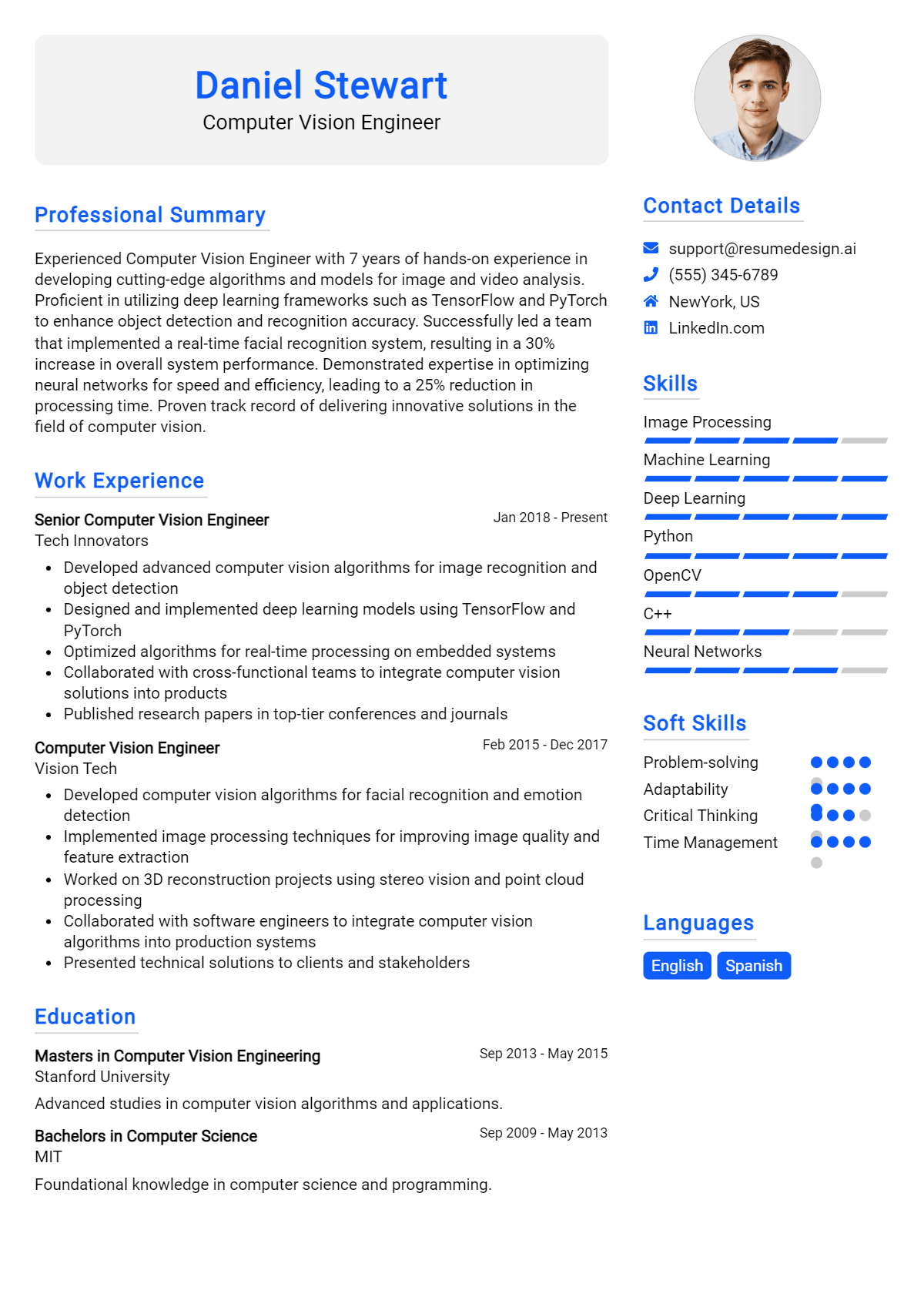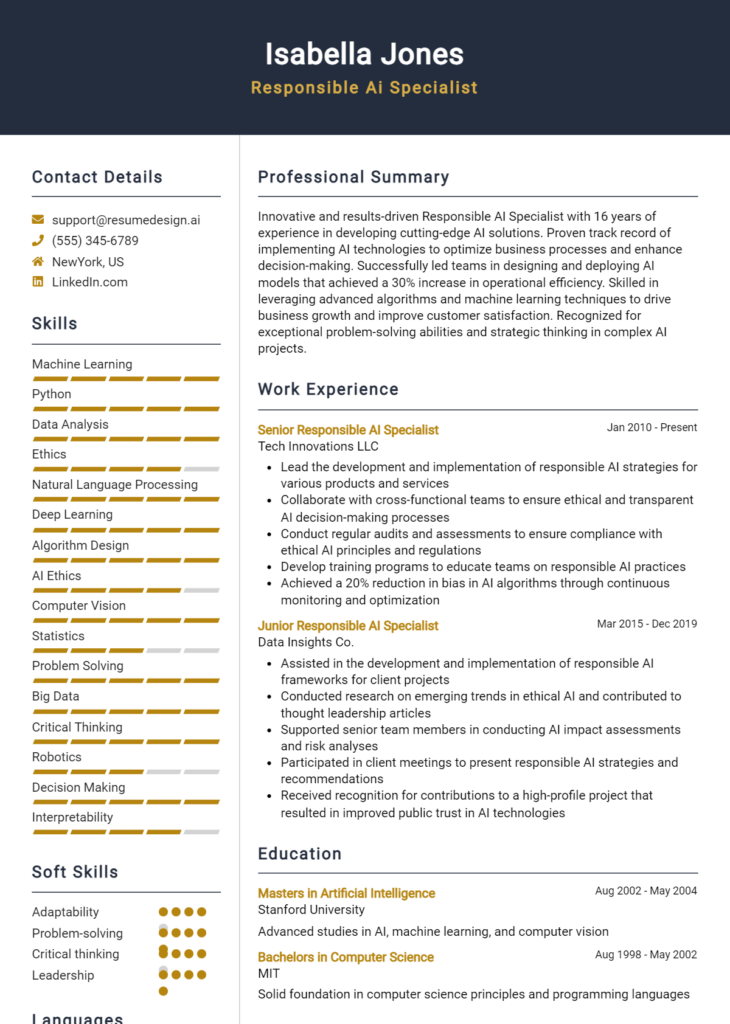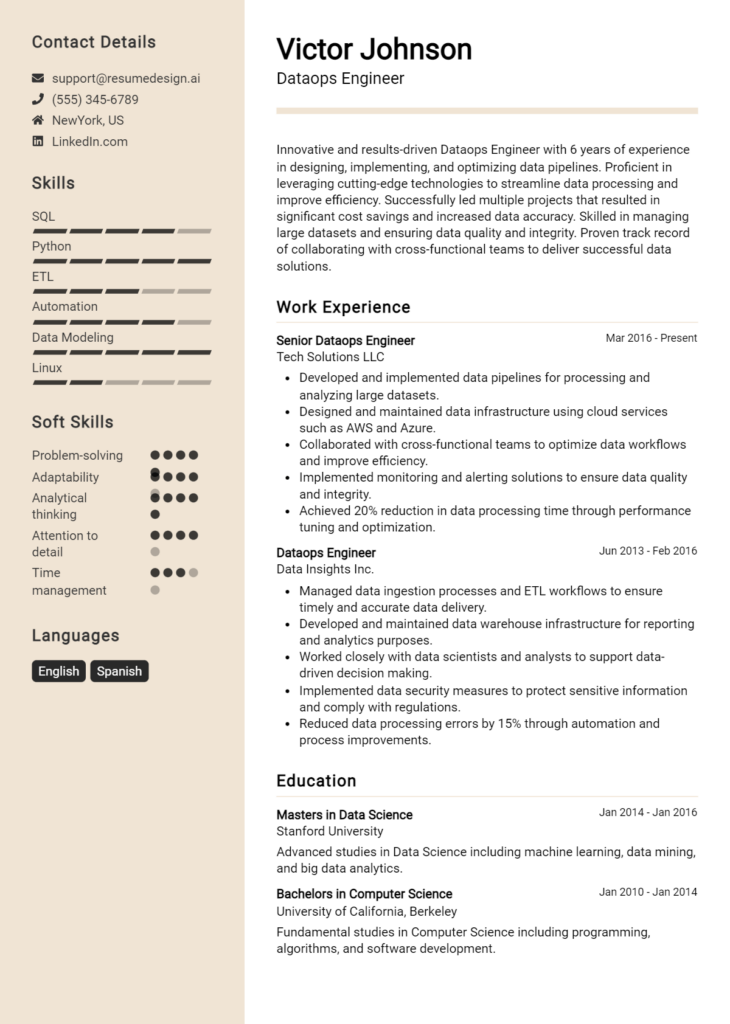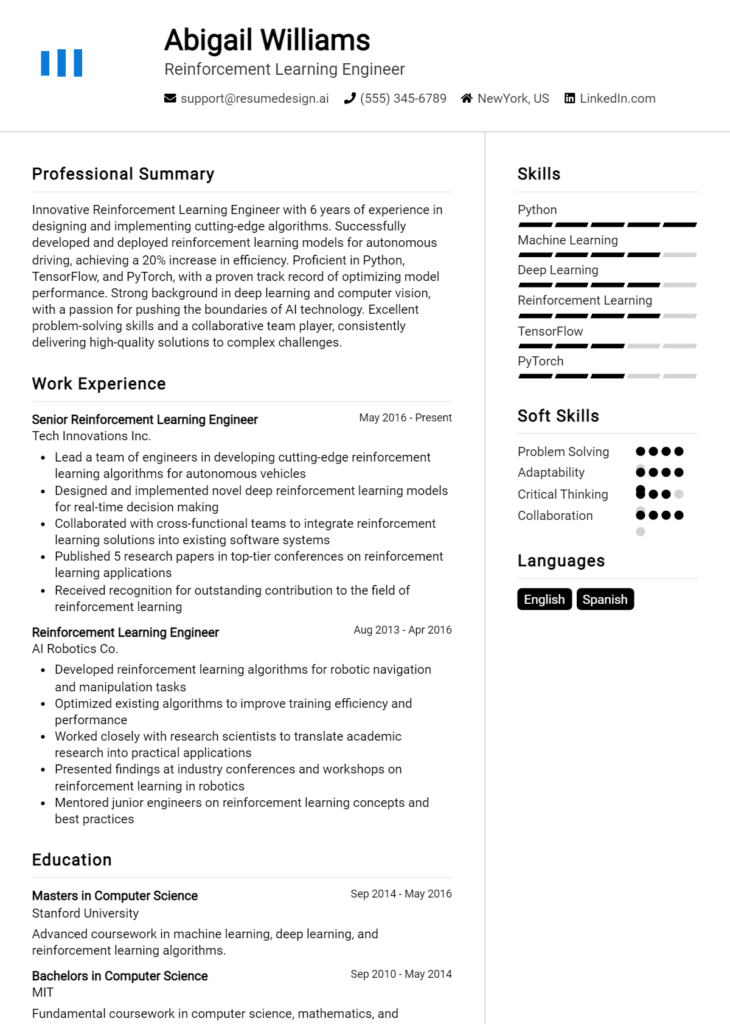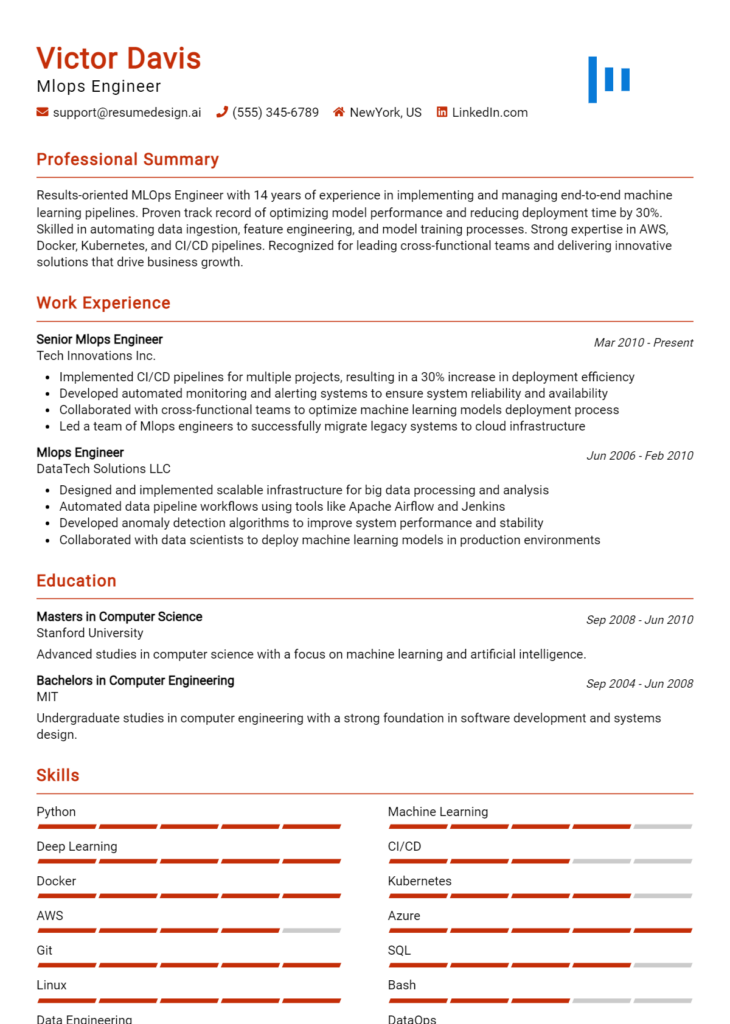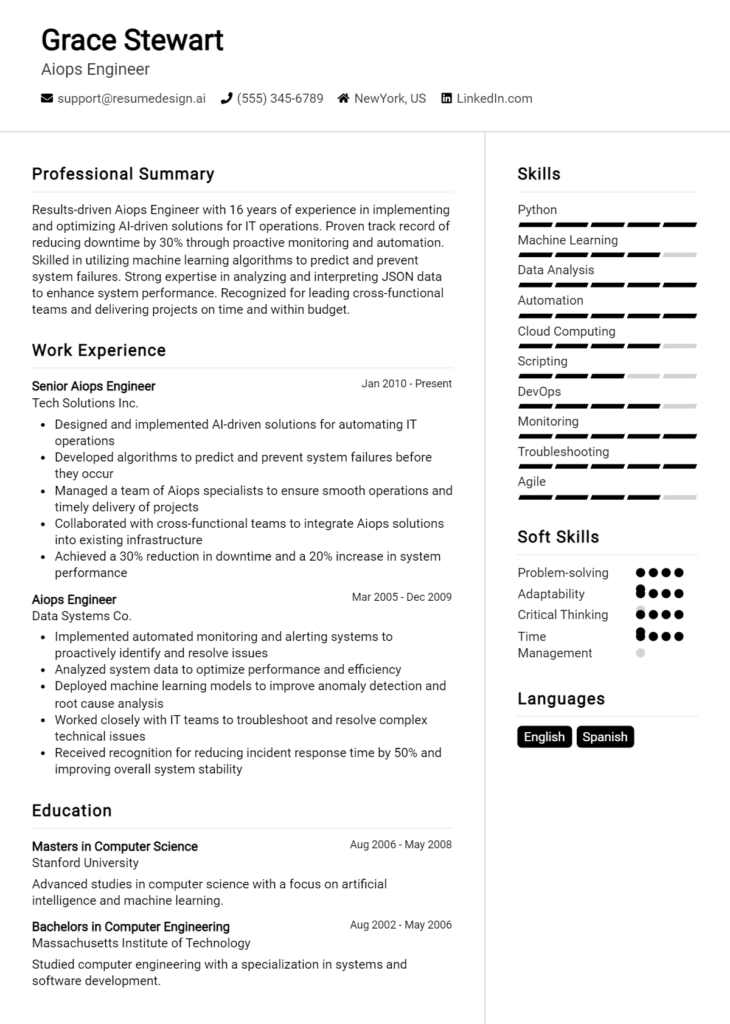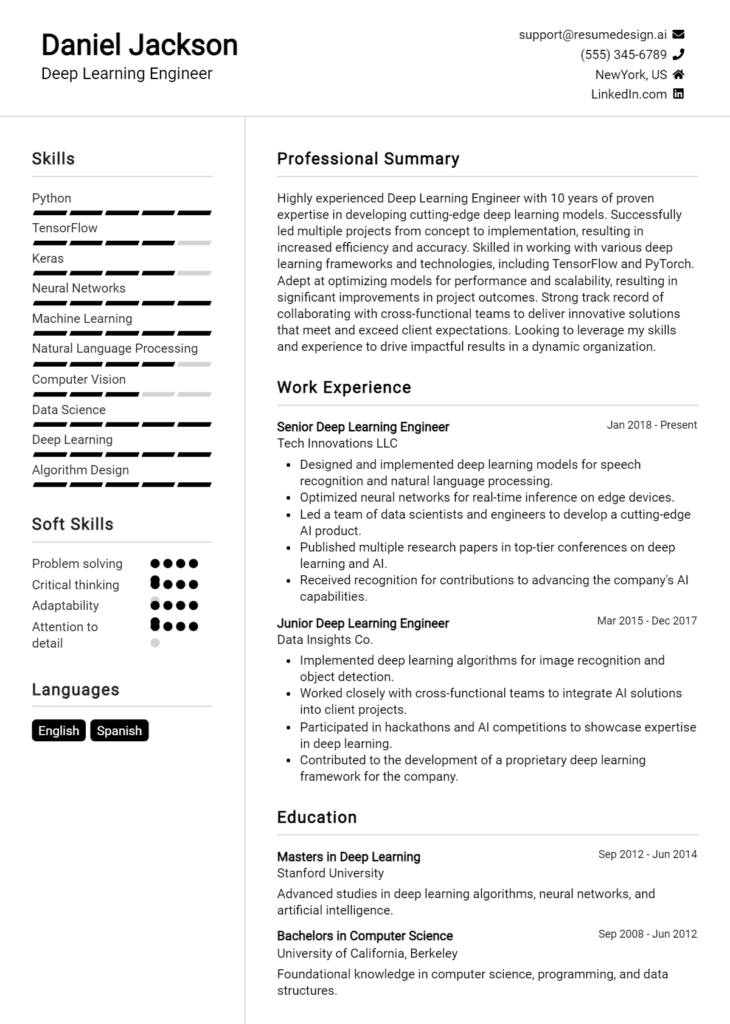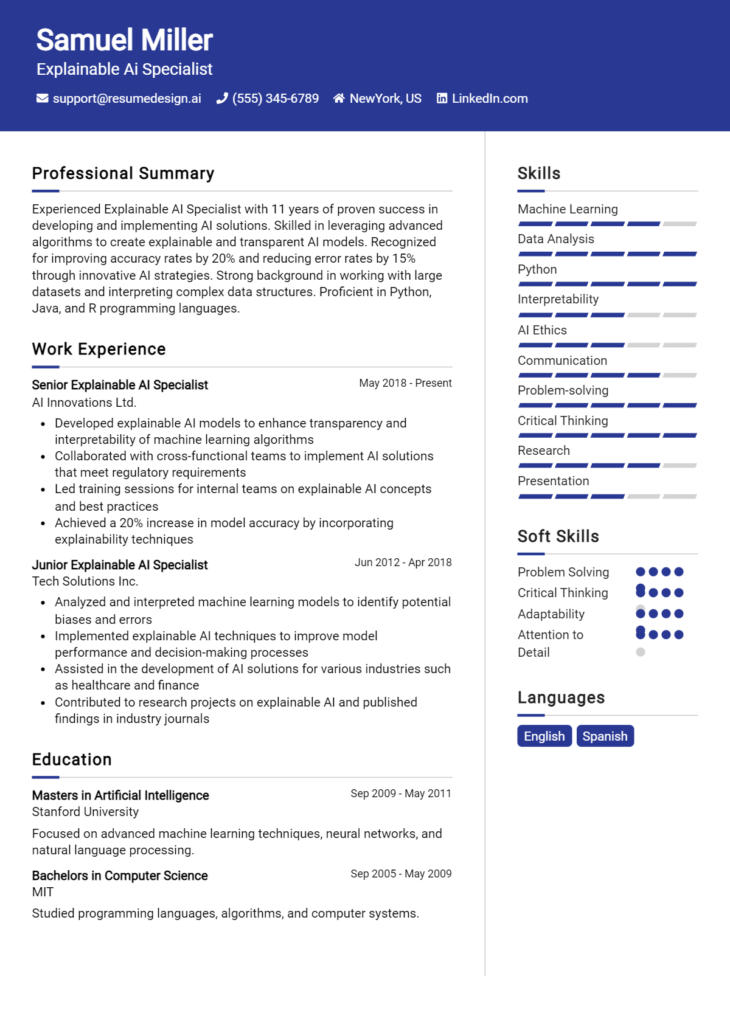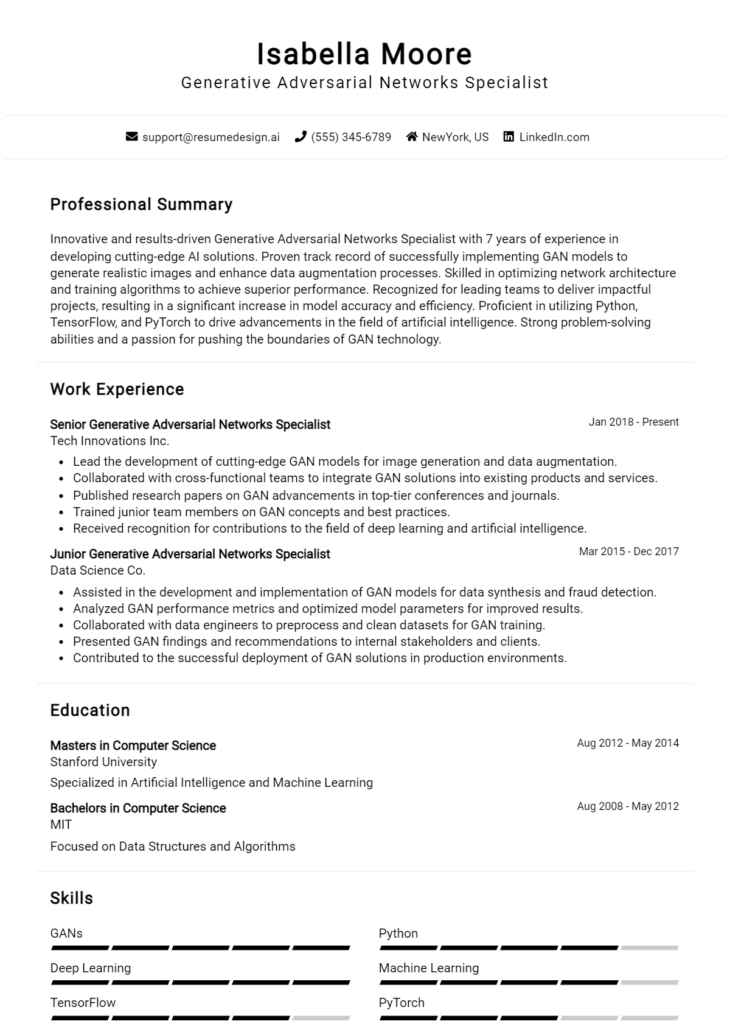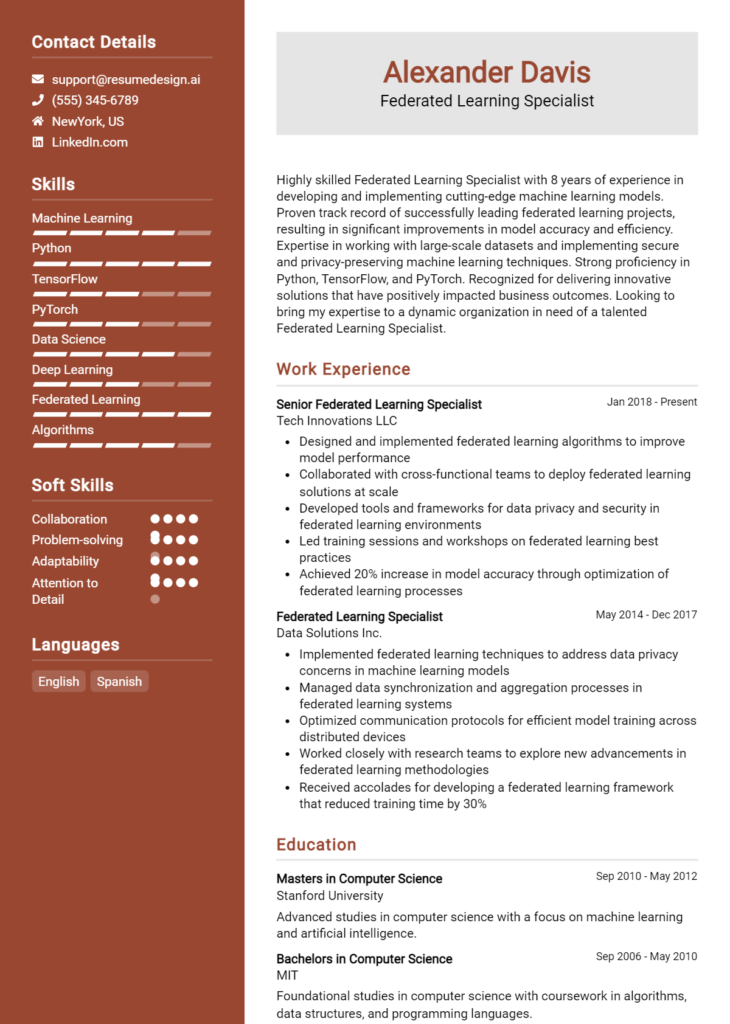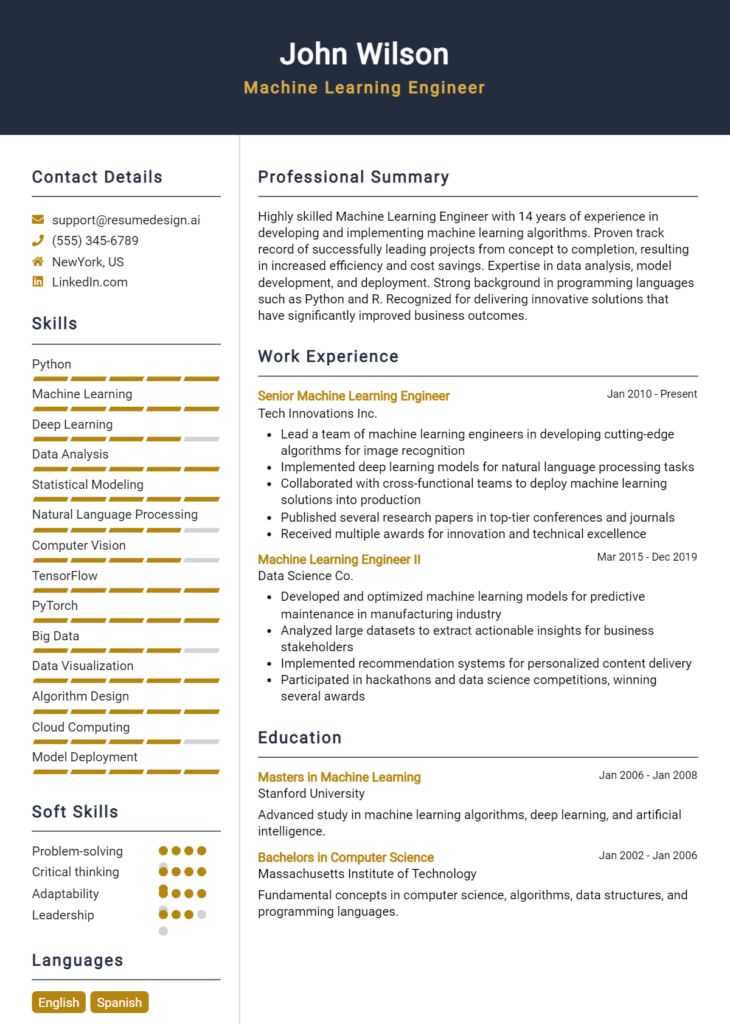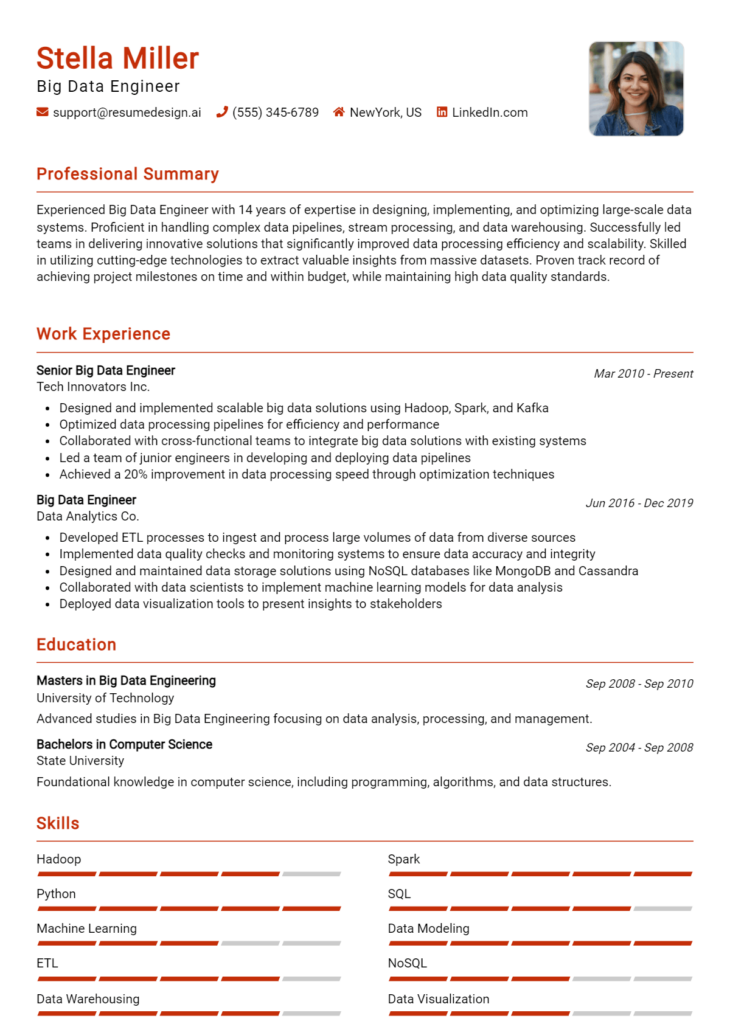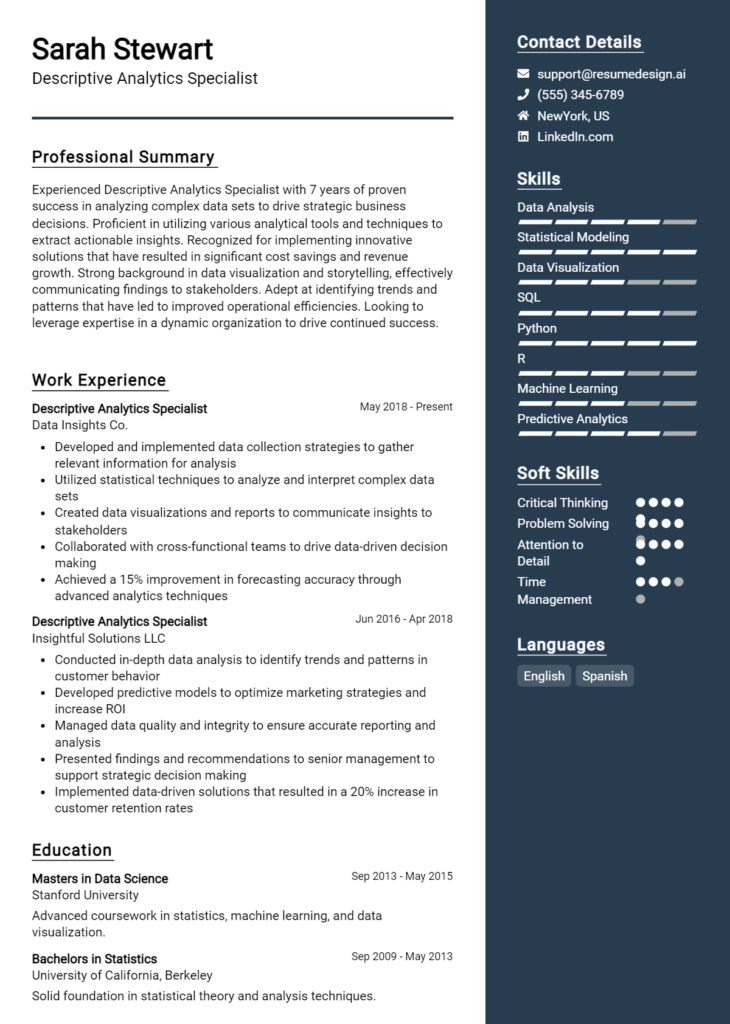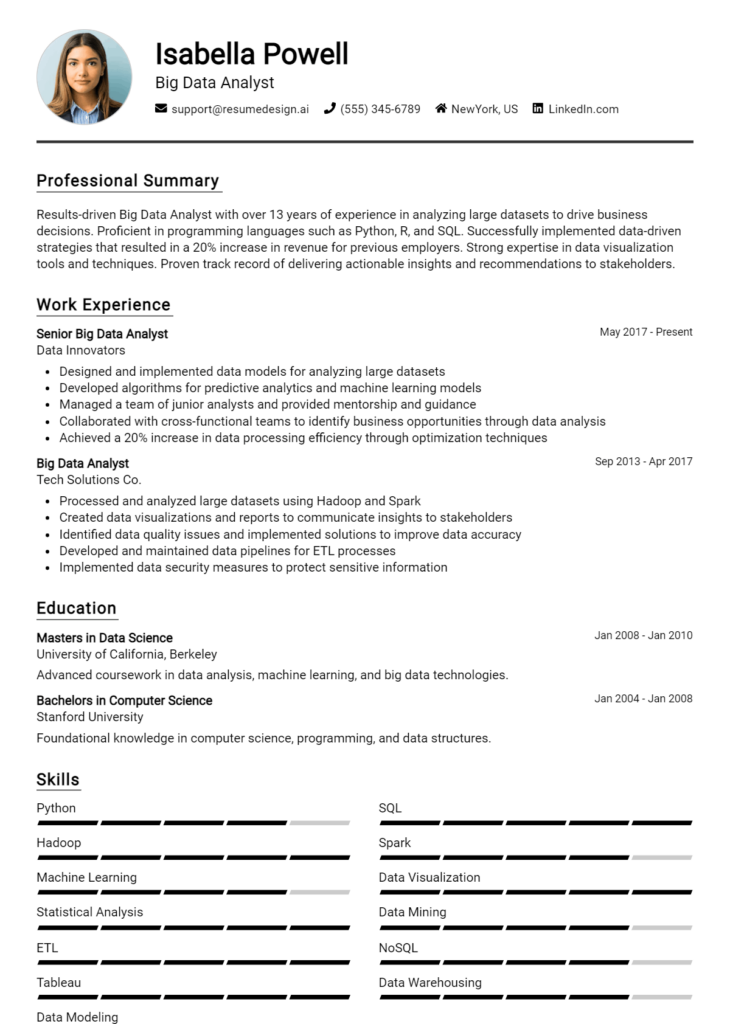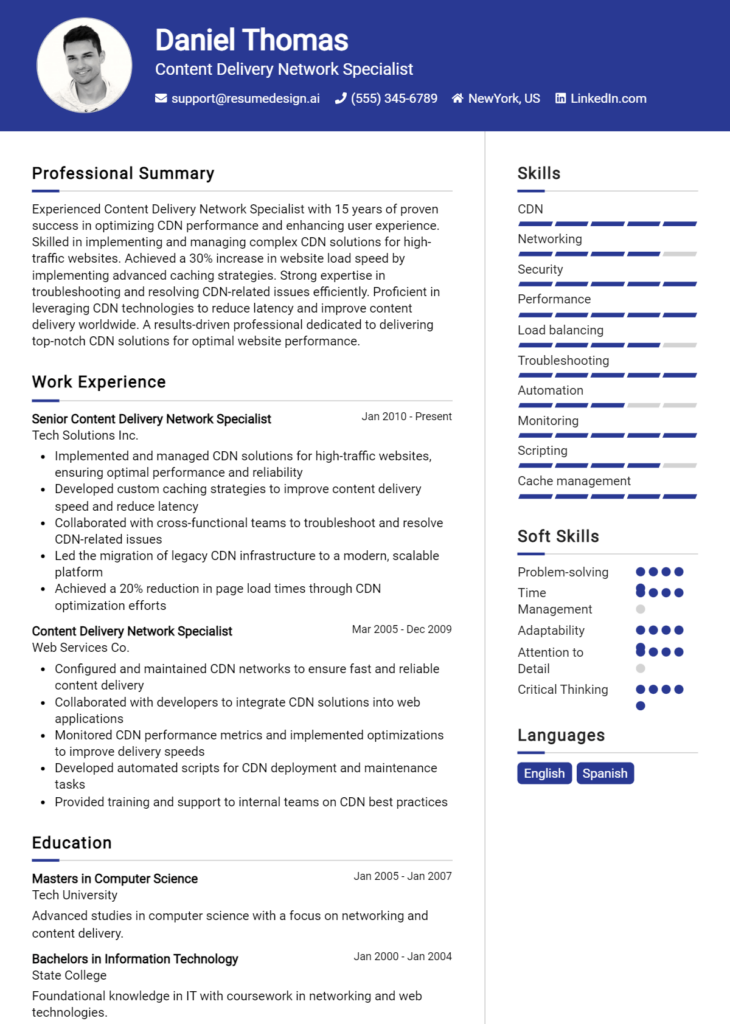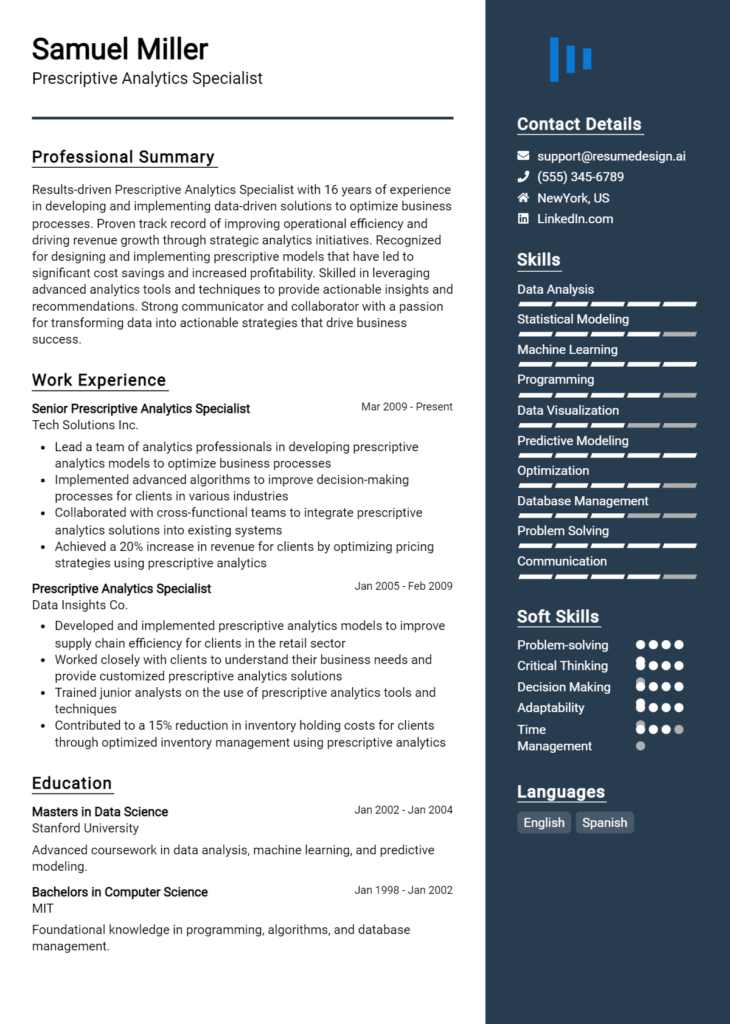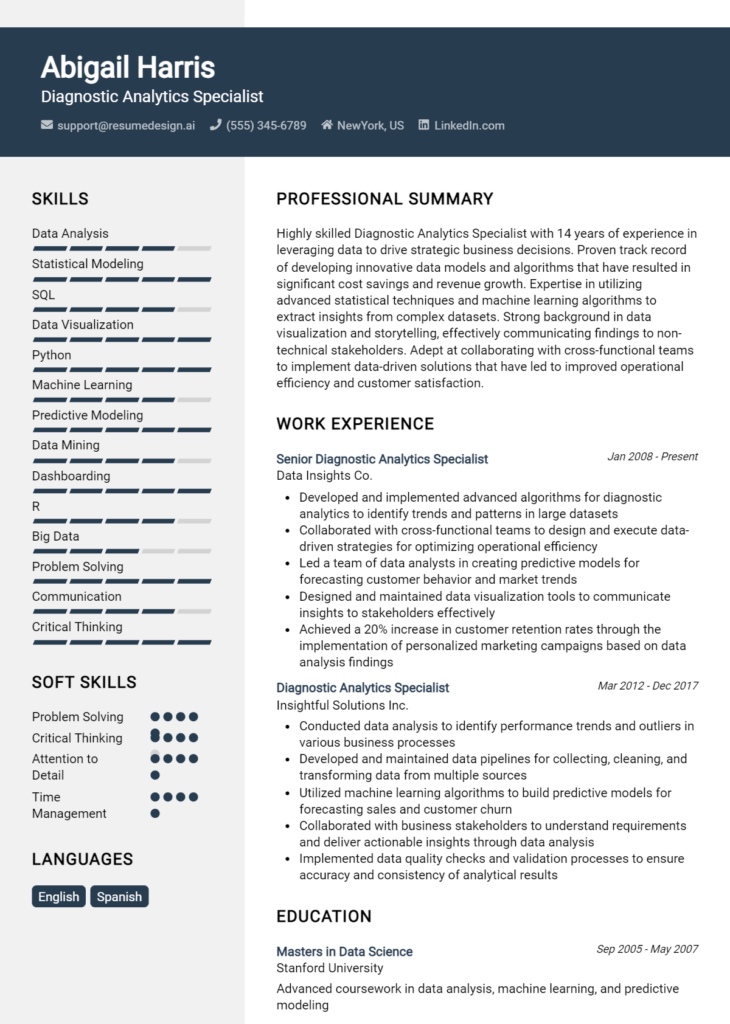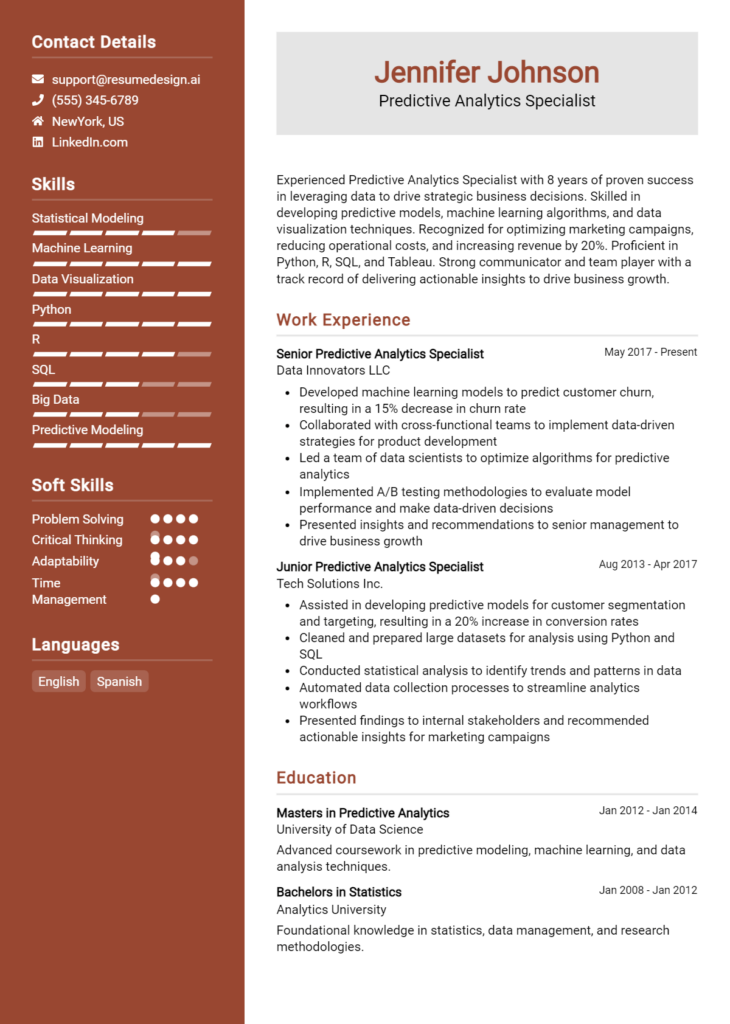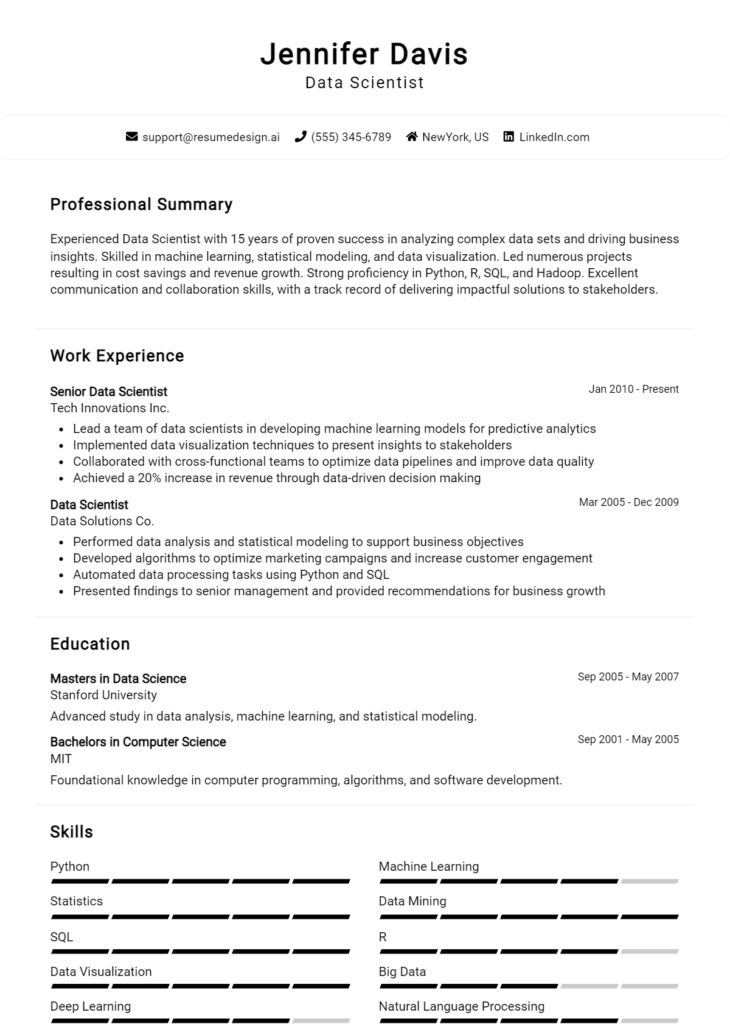Computer Vision Engineer Core Responsibilities
A Computer Vision Engineer plays a crucial role in developing algorithms and models that enable machines to interpret visual data. This position requires strong technical skills in programming, machine learning, and image processing, alongside operational capabilities for deploying solutions across various departments. Effective problem-solving skills are essential for tackling complex challenges and enhancing product functionality. A well-structured resume that highlights these skills and responsibilities can significantly contribute to achieving the organization's goals by attracting the right talent.
Common Responsibilities Listed on Computer Vision Engineer Resume
- Develop and implement computer vision algorithms for image and video analysis.
- Collaborate with data scientists and software engineers to integrate models into applications.
- Conduct research to improve existing computer vision techniques and algorithms.
- Optimize algorithms for performance and scalability in real-time applications.
- Analyze and preprocess image datasets for training and validation.
- Design and conduct experiments to evaluate model performance.
- Utilize deep learning frameworks such as TensorFlow and PyTorch.
- Document processes and maintain code repositories for future reference.
- Stay updated with advancements in computer vision technology and methodologies.
- Provide technical support and guidance to cross-functional teams.
- Develop prototypes and proof-of-concept applications to demonstrate capabilities.
High-Level Resume Tips for Computer Vision Engineer Professionals
A well-crafted resume is crucial for Computer Vision Engineer professionals, serving as the first impression a candidate makes on potential employers. In a competitive field where technical expertise and innovative thinking are paramount, your resume must effectively showcase both your skills and achievements. It needs to reflect not only your proficiency in computer vision technologies but also your ability to contribute to the success of a project or organization. This guide will provide practical and actionable resume tips specifically tailored for Computer Vision Engineer professionals, enabling you to stand out in the job market.
Top Resume Tips for Computer Vision Engineer Professionals
- Tailor your resume to the specific job description by incorporating relevant keywords and phrases that align with the job requirements.
- Highlight your technical skills, such as experience with machine learning algorithms, image processing, and deep learning frameworks like TensorFlow or PyTorch.
- Showcase relevant experience by detailing projects where you applied computer vision techniques, including any internships or research work.
- Quantify your achievements, such as the percentage improvement in accuracy or efficiency of a model you developed, to demonstrate your impact.
- Include any publications or presentations related to computer vision to establish your expertise and commitment to the field.
- List relevant certifications or courses that enhance your qualifications, such as specialized training in AI or computer vision.
- Utilize a clean and professional format, ensuring that your resume is easy to read and visually appealing.
- Incorporate soft skills such as problem-solving, teamwork, and communication, which are essential for collaborative projects in computer vision.
- Keep your resume concise, ideally within one to two pages, focusing on the most relevant information for the position.
By implementing these tips, you can significantly increase your chances of landing a job in the Computer Vision Engineer field. A well-structured and tailored resume will effectively communicate your technical prowess and unique contributions, making you a compelling candidate in a rapidly evolving industry.
Why Resume Headlines & Titles are Important for Computer Vision Engineer
In the competitive field of computer vision engineering, a well-crafted resume headline or title plays a crucial role in capturing the attention of hiring managers. A strong headline serves as a quick snapshot of a candidate's key qualifications, encapsulating their skills, experience, and the unique value they bring to the role. By being concise and relevant, a compelling headline can immediately engage the reader and encourage them to delve deeper into the resume. Thus, it is essential to ensure that the headline is directly related to the specific job being applied for, effectively summarizing the candidate's professional identity in just a few impactful words.
Best Practices for Crafting Resume Headlines for Computer Vision Engineer
- Keep it concise: Aim for one impactful sentence or phrase.
- Be specific: Use industry-related terms that reflect your expertise in computer vision.
- Highlight key skills: Mention core competencies relevant to the job description.
- Use action words: Start with strong verbs to convey your active role in past projects.
- Quantify accomplishments: Whenever possible, include metrics or results to demonstrate success.
- Tailor to the job: Customize your headline for each application to align with the employer's needs.
- Avoid jargon: Use clear language that can be easily understood by hiring managers.
- Showcase unique value: Highlight what makes you different from other candidates.
Example Resume Headlines for Computer Vision Engineer
Strong Resume Headlines
Innovative Computer Vision Engineer with 5+ Years of Experience in Deep Learning Algorithms
Results-Driven Computer Vision Specialist Focused on Real-Time Object Detection Solutions
Skilled Computer Vision Engineer with Proven Track Record in Developing AI-Powered Image Recognition Systems
Weak Resume Headlines
Computer Vision Engineer
Experienced in Technology
The strong resume headlines are effective because they not only specify the candidate's role but also highlight their relevant experience and achievements in a way that resonates with potential employers. This specificity and clarity help set them apart in a sea of applications. In contrast, the weak headlines fail to impress due to their vagueness and lack of detail, making it difficult for hiring managers to gauge the candidate's qualifications or the unique contributions they could bring to the organization. A strong headline serves as a powerful first impression, while a weak one may lead to missed opportunities.
Writing an Exceptional Computer Vision Engineer Resume Summary
A well-crafted resume summary is crucial for a Computer Vision Engineer, as it serves as the first impression for hiring managers. This concise statement quickly captures attention by highlighting key skills, relevant experience, and noteworthy accomplishments tailored to the specific job. A strong summary not only showcases the candidate's technical expertise in areas such as machine learning and image processing but also reflects their ability to deliver impactful results. In a competitive job market, an exceptional resume summary can significantly enhance a candidate's chances of landing an interview.
Best Practices for Writing a Computer Vision Engineer Resume Summary
- Quantify achievements: Use numbers to highlight the impact of your work, such as improvements in accuracy or processing time.
- Focus on relevant skills: Emphasize technical skills specific to computer vision, such as deep learning frameworks, image classification, and object detection.
- Tailor the summary: Customize your summary for each job application by incorporating keywords from the job description.
- Be concise: Keep your summary to 2-3 sentences that pack a punch with impactful information.
- Showcase relevant experience: Highlight your experience in projects or roles that directly relate to computer vision.
- Include soft skills: Mention soft skills, such as problem-solving and teamwork, that enhance your technical capabilities.
- Use strong action verbs: Start sentences with dynamic verbs to convey confidence and proactivity.
- Avoid jargon: While technical terms are necessary, ensure the language is accessible and clear to a variety of readers.
Example Computer Vision Engineer Resume Summaries
Strong Resume Summaries
Results-driven Computer Vision Engineer with over 5 years of experience in developing scalable image recognition systems, achieving 95% accuracy in classification tasks. Proficient in TensorFlow and PyTorch, successfully led a team that reduced processing time by 30% through innovative algorithm optimization.
Dedicated Computer Vision Specialist with a proven track record of deploying machine learning models, enhancing object detection capabilities by 40% for a major retail client. Adept at utilizing OpenCV and deep learning techniques to drive project success in fast-paced environments.
Innovative Computer Vision Engineer with expertise in 3D reconstruction and image segmentation. Developed a real-time video processing application that improved user engagement metrics by 25%, leveraging advanced neural network architectures.
Weak Resume Summaries
Computer Vision Engineer with some experience in various projects. Skilled in programming and machine learning.
Dedicated engineer interested in computer vision and related fields. Looking to apply my skills in a new role.
The strong resume summaries are considered effective because they provide specific achievements, quantify results, and demonstrate a clear connection to the candidate's skills and experience relevant to computer vision. In contrast, the weak summaries lack specificity and measurable outcomes, making them generic and less compelling to hiring managers. They fail to highlight the unique contributions the candidate can offer, which diminishes their impact in a competitive job market.
Work Experience Section for Computer Vision Engineer Resume
The work experience section of a Computer Vision Engineer resume is paramount as it provides a platform to demonstrate the candidate's technical skills, project management abilities, and dedication to delivering high-quality products. This section not only showcases specific technical proficiencies in areas such as image processing, machine learning, and algorithm development, but also highlights the candidate's capacity to lead teams effectively and collaborate with cross-functional departments. Quantifying achievements—such as improvements in processing times, accuracy rates, or project deliverables—coupled with aligning experiences to industry standards, is crucial in making a compelling case for the candidate's qualifications.
Best Practices for Computer Vision Engineer Work Experience
- Use specific technical terminology relevant to computer vision, such as 'deep learning', 'neural networks', and 'image segmentation'.
- Quantify achievements with metrics, such as percentage improvements or dollar savings.
- Highlight leadership roles and team management experiences, emphasizing collaboration and mentorship.
- Demonstrate adaptability by showcasing diverse projects across different domains or technologies.
- Include relevant industry standards and methodologies used in project execution.
- Tailor your experiences to align with job descriptions and employer requirements.
- Incorporate any notable technologies or tools (e.g., TensorFlow, OpenCV) used in your projects.
- Showcase successful outcomes that resulted from your work, including user satisfaction or product performance improvements.
Example Work Experiences for Computer Vision Engineer
Strong Experiences
- Led a team of 5 engineers to develop a real-time image recognition system, achieving a 95% accuracy rate and reducing processing time by 30%.
- Implemented a convolutional neural network for object detection that increased detection speed by 40%, resulting in a $250,000 savings in operational costs.
- Collaborated with cross-functional teams to deploy a machine learning model in a production environment, improving product quality ratings by 20%.
- Designed and executed a computer vision algorithm that automated quality inspection processes, which reduced error rates by 50% and improved production efficiency.
Weak Experiences
- Worked on various computer vision projects.
- Assisted in the development of image processing software.
- Helped with team tasks and contributed to project goals.
- Participated in machine learning activities.
The examples provided illustrate a clear distinction between strong and weak experiences. Strong experiences are characterized by specific accomplishments, quantifiable results, and leadership roles, demonstrating both technical expertise and an ability to drive project success. In contrast, weak experiences lack detail, specificity, and measurable outcomes, making them less impactful and failing to convey the candidate's true capabilities in the field of computer vision.
Education and Certifications Section for Computer Vision Engineer Resume
The education and certifications section of a Computer Vision Engineer resume plays a crucial role in showcasing a candidate's academic background and professional qualifications. This section highlights the candidate's formal education, including relevant degrees, as well as industry-recognized certifications that demonstrate expertise in computer vision and related technologies. In an ever-evolving field like computer vision, continuous learning is vital; therefore, showcasing relevant coursework, certifications, and specialized training can greatly enhance a candidate's credibility. It also helps to align their qualifications with the specific requirements of the job role, making them a more competitive candidate in the eyes of potential employers.
Best Practices for Computer Vision Engineer Education and Certifications
- Include relevant degrees in fields such as Computer Science, Artificial Intelligence, or Electrical Engineering.
- List certifications from recognized organizations, such as NVIDIA, Coursera, or IEEE.
- Highlight any coursework that directly relates to computer vision, machine learning, or deep learning.
- Use clear and concise formatting for easy readability, including bullet points for certifications and degrees.
- Emphasize any specialized training programs or workshops attended in the field of computer vision.
- Ensure that the most recent and relevant educational experiences are listed first to capture attention.
- Consider including online courses or MOOCs that demonstrate commitment to continuous learning.
- Tailor the section to align with the specific job description, emphasizing qualifications that meet the employer's needs.
Example Education and Certifications for Computer Vision Engineer
Strong Examples
- M.S. in Computer Vision, Stanford University, 2021
- Certified TensorFlow Developer, Google, 2022
- Relevant Coursework: Deep Learning for Computer Vision, Image Processing, and Machine Learning Algorithms
- Professional Training: Advanced Computer Vision Techniques Workshop, MIT, 2023
Weak Examples
- B.A. in English Literature, University of California, 2018
- Certification in Basic Photography, Local Community College, 2020
- Relevant Coursework: Introduction to Computer Science, 2015
- Certification in Microsoft Office Suite, 2019
The examples provided illustrate the difference between strong and weak qualifications for a Computer Vision Engineer role. Strong examples are directly related to the field of computer vision and indicate advanced knowledge and skills that are in high demand. They reflect a focus on relevant education and certifications that enhance the candidate's technical expertise. In contrast, weak examples lack relevance to the job role and do not demonstrate the necessary qualifications or specialized knowledge required for a position in computer vision, thereby diminishing the candidate's appeal to potential employers.
Top Skills & Keywords for Computer Vision Engineer Resume
In the rapidly evolving field of computer vision, a well-crafted resume is essential for showcasing your qualifications and standing out to potential employers. The importance of highlighting key skills cannot be overstated, as they serve as indicators of your expertise and capabilities in this specialized area. A Computer Vision Engineer must not only possess technical knowledge but also demonstrate a range of soft skills that facilitate collaboration and problem-solving. Therefore, a comprehensive resume that effectively incorporates both hard and soft skills can significantly enhance your chances of landing the desired position. For more insights on how to optimize your resume, explore the skills and work experience sections.
Top Hard & Soft Skills for Computer Vision Engineer
Soft Skills
- Problem-solving
- Critical thinking
- Communication
- Team collaboration
- Adaptability
- Attention to detail
- Creativity
- Time management
- Analytical mindset
- Project management
Hard Skills
- Machine learning algorithms
- Image processing techniques
- Programming languages (Python, C++, etc.)
- Deep learning frameworks (TensorFlow, PyTorch)
- Computer vision libraries (OpenCV, scikit-image)
- Data preprocessing and augmentation
- Neural networks design and implementation
- 3D vision and reconstruction
- Object detection and recognition
- Familiarity with cloud computing platforms (AWS, Azure)
Stand Out with a Winning Computer Vision Engineer Cover Letter
Dear [Hiring Manager's Name],
I am writing to express my enthusiasm for the Computer Vision Engineer position at [Company Name]. With a Master’s degree in Computer Science and over three years of hands-on experience in developing and deploying advanced computer vision algorithms, I am excited about the opportunity to contribute to your innovative team. My background in machine learning and image processing, combined with my passion for developing cutting-edge technology, make me a strong candidate for this role.
At my previous position with [Previous Company Name], I successfully led a project that utilized deep learning techniques to enhance object recognition accuracy by over 30%. This involved collaborating closely with cross-functional teams to integrate computer vision solutions into existing applications. My proficiency in programming languages such as Python and C++, along with my experience with frameworks like TensorFlow and OpenCV, has enabled me to develop robust systems that deliver high performance in real-world scenarios. I am particularly proud of my work on a real-time video analysis system that significantly improved operational efficiency for our clients.
I am particularly impressed by [Company Name]'s commitment to leveraging artificial intelligence in [specific project or area]. I am eager to bring my skills in algorithm optimization and model training to your team, contributing to projects that push the boundaries of what is possible in computer vision. I thrive in collaborative environments and am excited about the prospect of working alongside talented professionals who share my enthusiasm for technology and innovation.
Thank you for considering my application. I am looking forward to the opportunity to discuss how my background, skills, and enthusiasms align with the goals of [Company Name]. I am excited about the possibility of contributing to your team and am eager to share how my experiences can help drive your projects forward.
Sincerely,
[Your Name]
[Your Phone Number]
[Your Email Address]
Common Mistakes to Avoid in a Computer Vision Engineer Resume
When crafting a resume for a Computer Vision Engineer position, it’s crucial to present your skills and experiences effectively to stand out in a competitive field. Many candidates make common mistakes that can undermine their qualifications or lead to their resumes being overlooked by hiring managers. By avoiding these pitfalls, you can enhance your chances of making a positive impression and securing an interview.
Vague Descriptions: Using general language without specific details can make your accomplishments seem less impressive. Instead, quantify your achievements with numbers or specific outcomes.
Ignoring Relevant Skills: Failing to include key computer vision skills, such as machine learning frameworks (like TensorFlow or PyTorch) or image processing libraries (like OpenCV), can lead to your resume being dismissed.
Lack of Tailoring: Sending out a generic resume instead of customizing it for each job application can make you appear uninterested. Tailoring your resume to highlight the skills and experiences that align with the job description is essential.
Overlooking Projects: Not mentioning relevant projects—whether academic, personal, or professional—can be a missed opportunity to showcase your practical application of computer vision techniques.
Excessive Technical Jargon: While it’s important to demonstrate your technical expertise, using too much jargon can alienate non-technical recruiters. Aim for a balance that showcases your skills while remaining accessible.
Ignoring Soft Skills: Focusing solely on technical skills at the expense of soft skills, such as teamwork and communication, can be detrimental. Employers often seek candidates who can collaborate effectively within teams.
Poor Formatting: A cluttered or poorly organized resume can make it difficult for hiring managers to find relevant information quickly. Use clear headings and bullet points to enhance readability.
Neglecting Continuous Learning: Not mentioning ongoing education or certifications in emerging technologies can signal a lack of commitment to professional growth. Showcasing your dedication to learning can set you apart from other candidates.
Conclusion
In today's rapidly evolving tech landscape, the role of a Computer Vision Engineer is more crucial than ever. As we explored, this position requires a blend of advanced technical skills, such as proficiency in machine learning algorithms, programming languages like Python and C++, and experience with deep learning frameworks. Additionally, a strong understanding of image processing techniques and the ability to work with large datasets are fundamental to success in this field.
Moreover, we highlighted the importance of keeping your skills updated with the latest advancements in computer vision technologies, such as convolutional neural networks and image recognition systems. Networking with peers and participating in relevant projects can also enhance your expertise and marketability.
As you reflect on your qualifications and experiences, it’s an excellent time to review and update your Computer Vision Engineer resume. Ensure that it effectively showcases your skills, projects, and accomplishments tailored to this specialized field.
To assist you in this process, consider utilizing available resources like resume templates, a customizable resume builder, and resume examples that can inspire your own layout and content. Don't forget to craft a compelling cover letter using our cover letter templates, which can make a significant difference in your job application.
Take action today—revise your resume and position yourself as a standout candidate in the competitive field of computer vision engineering!

